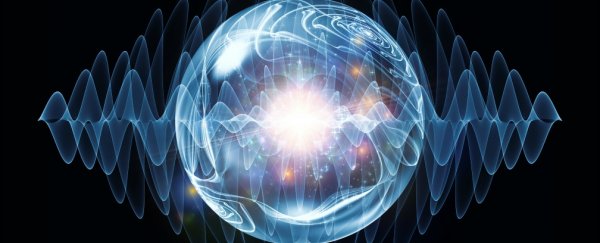Physicists have confirmed that distant particles really can influence each other and act in strange ways that can't be explained by common sense or, for the most part, the laws of physics.
This bizarre behaviour is what's known as quantum 'spookiness', and despite plenty of experiments showing that it exists, this is the first time it's been demonstrated with a loophole-free test, proving that Albert Einstein was wrong about quantum mechanics.
According to quantum theory, a particle's nature doesn't exist until it's measured, which means it just hangs out in a superposition state until someone decides to check in on it. Particles can also be entangled, which means that they're inextricably linked together, and their nature is only defined by being the opposite of the other one.
So that means when you measure a particle, you're not only determining its nature in that moment, you're also defining the nature of its entangled partner. And that definition happens instantly, no matter how far apart the particles are. It's for this reason that Einstein, and many other physicists, have doubted the existence of quantum entanglement, because it essentially means that information is passing between the two entangled particles faster than the speed of light (like we said, freaking weird).
This latest experiment involved physicists from the Netherlands, the UK, and Spain, who entangled pairs of electrons separated by a distance of 1.3 km. Led by Delft University of Technology researcher B. Hensen from the Netherlands, the team then measured one of the electrons while a group immediately observed whether its partner was affected.
This is a take on the classic 'Bell experiment' devised in the 1960s by Irish physicist John Bell to test whether there was a more sensible explanation for entanglement. According to the rational view of the world, after a certain distance, the correlation should cease to exist as the particles are too far away to communicate with each other. But according to quantum theory, there will be no distance limit.
Over the past 30 years or so the Bell experiment has been attempted many times, always showing that quantum theory is real. But in all those experiments there have been loopholes - usually the fact that most researchers entangle photons, which are hard to pin down and measure due to their super-fast nature, so as many as 80 percent are lost before being measured, making results inconclusive.
In an attempt to close that loophole, many physicists use entangled ions instead of photons. But this opens up another loophole, because these ions aren't kept far enough apart to rule out that they aren't somehow influencing each other by communicating information normally - in other words, at a rate less than the speed of light.
The new experiment managed to close both those loopholes by combining the benefits of photons with electrons, which are easier to measure. To do this, the team entangled the spin of two electrons with two different photons. Those two electrons were located in labs 1.3 km apart, while the photons were sent off to a third location and then separately entangled with each other.
"As soon as the photons are entangled, BINGO, so too are the two original electron spins, seated in vastly distant labs, reports science writer Zeeya Merali over at FQXi blogs. "The team carried out 245 trials of the experiment, comparing entangled electrons, and report that Bell's bound is violated."
So that means that there really is some freaky quantum behaviour going on, and the results can't be blamed on some kind of loophole.
"Our experiment realises the first Bell test that simultaneously addresses both the detection loophole and the locality loophole," the authors write over at arXiv, where they've published the early results. They're now refining the experiment for publication in a peer-reviewed journal.
"It's a very nice and beautiful experiment, and one can only congratulate the group for that," Anton Zeilinger, the leader of a rival team at the University of Vienna in Austria, who wasn't involved in the research, told Jacob Aron over at New Scientist. "I expect they have improved the experiment, and by the time it is published they'll have better data … There is no doubt it will withstand scrutiny."
But there's another reason that people have been so keen to conduct a loophole-free Bell test. It's also a huge step towards quantum cryptography, which is a hypothesised un-hackable security system that depends on entangled particles for verification.
As you can imagine, such a system would be incredibly lucrative for a world desperate for better Internet. And right now it seems that Hensen and his co-workers may have finally nailed it. We're excited to see what happens next.
